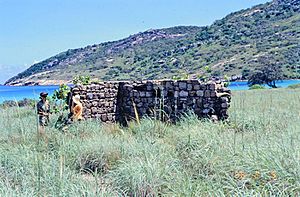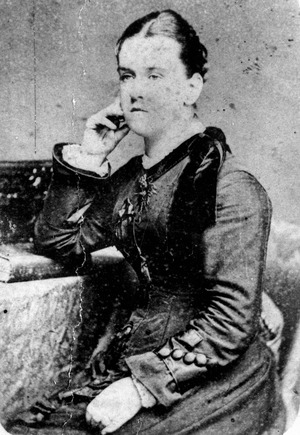Mrs Watson's Cottage facts for kids
Quick facts for kids Mrs Watson's Cottage |
|
|---|---|

Stone ruins, 1996
|
|
| Location | Lizard Island National Park, Shire of Cook, Queensland, Australia |
| Official name: Stone ruin at Lizard Island, 'Mrs Watson's Cottage | |
| Type | state heritage (archaeological) |
| Designated | 21 October 1992 |
| Reference no. | 600430 |
| Significant period | 1860s-c. 1880 (fabric) 1881 (historical) |
| Lua error in Module:Location_map at line 420: attempt to index field 'wikibase' (a nil value). | |
The stone ruins known as Mrs Watson's Cottage are found on Lizard Island National Park in Queensland, Australia. This site is protected because it is important to history. It is also called the Stone ruin at Lizard Island. The ruins were added to the Queensland Heritage Register on 21 October 1992.
History of Lizard Island
The stone ruins at Watson's Bay on Lizard Island might be connected to European fishing for sea cucumbers in the 1800s. Sea cucumbers were a valuable food. These ruins are famously linked to the sad story of Mary Watson, her baby son, and two Chinese workers in 1881. This happened after a conflict with Aboriginal people from the mainland.
Early Use by Aboriginal People
Aboriginal people lived on Lizard Island for thousands of years before Europeans arrived. It is believed they used the island for special ceremonies. In 1770, Captain James Cook sailed past and saw signs of huts and large shell middens (old piles of food scraps).
Sea Cucumber Fishing
Fishermen from Sulawesi (an island in Indonesia) began collecting sea cucumbers along the north Australian coast around 1700. They would boil and smoke the sea cucumbers on shore to preserve them. Europeans joined this trade in the early 1800s.
In 1860, a group of Europeans, Chinese, and South Sea Islanders came to Lizard Island. They wanted to set up a place to process sea cucumbers. They built a stone building. This business did not do well and was stopped in 1861. Other groups also worked there later, including over 40 South Sea Islanders in the late 1860s.
The Watson Family on Lizard Island
In 1879, Captain Robert Watson and P.C. Fuller started a sea cucumber processing station at Watson's Bay. They may have used or changed the stone building. In May 1880, Robert Watson married 20-year-old Mary Oxnam. Mary had moved from England in 1877.
The Watsons moved to Lizard Island. Robert built a home, a smokehouse, and a store. He also started a small garden. Two Chinese men, Ah Sam and Ah Leong, helped them. Mary went to Cooktown in March 1881 to have her first child. She returned to Lizard Island in July with her baby, Ferrier.
The Tragic Events of 1881
On 1 September 1881, Robert Watson and Fuller left for a fishing trip. They planned to be away for about six weeks. Mary was left on the island with her baby and the two Chinese workers.
On 27 September, a group of Aboriginal people arrived at Lizard Island. Oral traditions say this area had a sacred site near the sea cucumber station. On 29 September, they attacked and killed Ah Leong, who was working in the garden. The next day, they gathered on the beach. Mary fired a rifle and revolver, and they left. But on 1 October, they returned and badly wounded Ah Sam.
Mary feared another attack. She had no other way to escape. She put some belongings, food, water, and two paddles into a large iron tank. This tank was normally used for boiling sea cucumbers. On 2 October, she, Ah Sam, and the baby set off in the tank.
They reached No.5 Howick Island. This island was on the steamer route, but it had no fresh water. They were too weak to continue. They hoped a passing ship would see them, but none did. They sadly died from thirst. Mary kept a short diary during this time. Her diary showed her courage and efforts to protect her child. The last entry was on 11 October 1881.
After the Tragedy
Robert Watson returned to find signs of an attack and his family missing. He began searching for them. This event made tensions worse between Europeans and Aboriginal people in the Cooktown area. An attack was carried out, and many people were killed. However, the people targeted were not those actually responsible.
On 19 January 1882, a fishing boat crew found the remains of Mary, Ah Sam, and baby Ferrier. They had a very large public funeral in Cooktown. In 1885, people raised money to build the Mary Watson's Monument. This memorial, a drinking fountain, was put up in Cooktown in 1886. The iron tank Mary used to escape was displayed at the Queensland Museum for many years.
Lizard Island became a National Park in 1939. Today, there is a resort to the west of the ruins. The story of Mary Watson continues to be remembered. The ruins, believed to be her cottage, remain a place that reminds people of this sad event in the early European settlement of North Queensland.
What the Ruins Look Like
The stone ruins are about 60 meters from Watson's Beach. They are also about 35 meters northwest of Ferrier's Creek. Lizard Island is a high, rocky island about 90 kilometers northeast of Cooktown.
The ruins are the foundations and parts of the walls of what was once a five-room building. It measured about 14 by 10 meters. It looks like it was built in different stages. Most of the building has fallen down. Only the northwestern corner still stands to its full height, which is about two meters. Parts of a fallen inner wall and scattered stones are also there.
The walls are made from local granite stones. They were laid in neat rows, with bands at different heights. The stones were held together with a special cement. This cement was made from burnt coral and beach sand.
Why Mrs Watson's Cottage is Important
Mrs Watson's Cottage was added to the Queensland Heritage Register on 21 October 1992. This means it is considered very important for several reasons:
Showing Queensland's History
Even if Mary Watson did not live in these exact ruins, they represent a key time in Queensland's history. They show how Europeans came into lands that Aboriginal people had used for a long time. They also remind us of the sad conflicts that happened as both groups tried to use the same land. Mary Watson's brave but tragic death made many people feel sad and admire her courage. It also affected how people felt about Aboriginal people in the area. The building might also be linked to the sea cucumber fishing industry, which was important in the Cooktown area in the 1800s.
Learning About the Past
We do not fully know the exact age, origin, or use of the building. The ruins and the area around them could help us learn more about this. They might also give us information about the sea cucumber industry in North Queensland in the late 1800s.
Beautiful and Moving
The ruins on Lizard Island are visually appealing. They are a picturesque old ruin in a quiet place overlooking the sea. They make visitors feel empathy for Mrs. Watson's tragic story.
Important to Cultural Groups
The traditional Aboriginal people of the area, the Dingaal, see this site as very important. For them, it represents the end of their traditional ways of life. It also shows their displacement from their lands, the disrespect of sacred sites, and the competition with Europeans for resources.
Connection to Important People
Many people believe these ruins are connected to Mary Watson. They act as a powerful reminder of her difficult experience and death.



